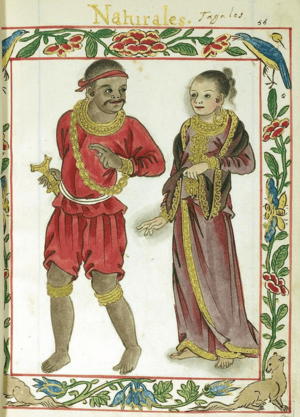Maharlika facts for kids
The maharlika were a special group of warriors in ancient Tagalog society, found mostly in Luzon, Philippines. They were considered freemen and belonged to a lower noble class, similar to the timawa of the Visayan people. Today, the word "maharlika" is sometimes mistakenly used to mean royal nobility, but that was actually the role of the maginoo class.
Contents
Who Were the Maharlika?

The maharlika were a class of free warriors. They were loyal followers of their leader, called a datu. They didn't have to pay taxes or tributes. Instead, they had to serve as soldiers.
When there was a war, the maharlika had to bring their own weapons. They would join their datu in battles. In return, they received a share of the treasures won in battle, called ganima. The leader (Ginoo) got a share, and the maharlika shared the rest with their own fighters. Sometimes, the maharlika also helped their datu with farm work or community projects.
Unlike the timawa from the Visayas, the maharlika were more focused on fighting. While maharlika could choose to follow a different datu, they had to host a feast for their old datu and pay a fee (about six to eighteen pieces of gold). After this, they were free to leave. The timawa, however, could change leaders more easily.
One of the first mentions of the term "maharlika" is in the Boxer Codex, where it means "freeman." The Franciscan friar Juan de Plasencia also wrote about the maharlika in the 16th century. He explained that they were different from the maginoo class, who were the true hereditary nobles and included the datu. Historian William Henry Scott believed that the maharlika might have been skilled warriors who married into noble families. Or they could have been nobles from groups that were conquered.
After the Spanish arrived and took control, they called the maharlika "Hidalgos," which meant "freemen" or "nobles."
Where Does the Word "Maharlika" Come From?
The word maharlika comes from the ancient Sanskrit word maharddhika. This word meant "a person with wealth, knowledge, or ability." It's important to remember that in ancient times, maharlika did not mean the ruling class. It referred to a warrior class, a type of minor nobility, similar to the Visayan timawa.
In other languages, like Malay and some languages spoken by the Moro people in the Philippines, similar words like mardika or merdeka mean "freedom" or "freemen." This is the opposite of being a servant or slave. The Malay word mandulika also meant "governor."
Modern Use of the Word
During the Marcos Era
During the time of President Ferdinand Marcos in the Philippines, he used the word maharlika to promote his idea of Filipino nationalism. He claimed that maharlika referred to the ancient Filipino nobility, including kings and princes. This was part of his "New Society Movement" during martial law.
Marcos made "maharlika" a popular name for streets, buildings, and organizations. He even named a highway, a broadcasting company, and a reception area in the presidential palace "Maharlika."
Marcos also said he led a group of fighters called the Maharlika Unit during World War II. He used "Maharlika" as his personal nickname. He even had a film made called Maharlika about his supposed war adventures. However, critics noted that the movie didn't actually show details from Marcos's alleged war stories.
As a New Name for the Philippines
In 1978, Senator Eddie Ilarde suggested changing the name of the Philippines to "Maharlika." He wanted to honor the country's ancient heritage before the Spanish and Americans arrived. President Ferdinand Marcos liked the idea, thinking "Maharlika" meant "nobility." In 2019, President Rodrigo Duterte also brought up the idea, believing it meant "serenity and peace."
See also
 In Spanish: Maharlika para niños
In Spanish: Maharlika para niños

